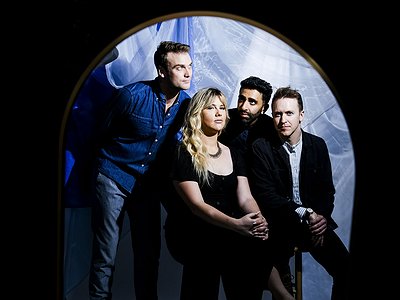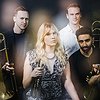Part 1
Name: The Westerlies
Members: Riley Mulherkar (trumpet player), Chloe Rowlands (trumpet player, composer, music educator), Andy Clausen (trombonist, composer, educator), Willem de Koch (trombonist, composer, educator)
Nationality: American
Current release: The Westerlies's Move is out now.
If you enjoyed this interview with The Westerlies and would like to stay up to date with the ensemble's music, releases, and tour dates, visit their official website. The group is also on Instagram, Facebook, twitter, and Soundcloud.
When did you first start getting interested in musical interpretation?
We all grew up as jazz musicians, so musical interpretation was always a part of what we do.
Inherent in jazz is the exercise of dealing with material from up to a century ago, learning from the masters who have recorded it and performed it for centuries, and then finding one’s own voice within the lineage. Because that was the lens through which we viewed music, it was natural for us to take the same approach in arranging a string quartet like Entr’acte, a shape note piece like Louisiana, or an a capella song by the Golden Gate Quartet.
The process of interpreting a wide variety of material has led to a number of unexpected musical discoveries that have informed all of the music we play, regardless of genre or category.
Which artists, approaches, albums or performances captured your imagination in the beginning when it comes to the art of interpretation?
One of our biggest inspirations from our earliest days has been folk singer-songwriter Sam Amidon. The way that he deals with American music traditions and interprets old songs in new and personal ways is profound, and his album All is Well was the soundtrack to our earliest tours.
It’s no coincidence that we ended up interpreting some of his songs in later years — first with “Saro”, and then years later with “Weeping Mary”, an old shape note song.
Are there examples for interpretations that were entirely surprising to you personally and yet completely convincing?
Yes to surprising, and hopefully yes to convincing as well! One example is Caroline Shaw’s string quartet Entr’acte — by far the most daunting arrangement we’ve ever done. The process alone took years of trial and error, but we were dedicated because we found the material so powerful and moving.
Each section of the piece required its own approach to interpretation and arrangement, but one passage that stands out as surprising but rewarding is the ending.
Originally written as a solo for cello playing pizzicato, we interpreted it as a brass chorale — a stark departure from the original, but to us it captures the same spirit and emotional message of the original work.
What, would you say, are the key ideas behind your approach to interpretation? Do you see yourself as part of a tradition or historic lineage?
The way we interpret material differs greatly from piece to piece — for example, the process through which we interpret a song like Arthur Russell’s “Eli” is quite different from the way we interpret an orchestral work like Andy Clausen’s “This Is Water”.
However, even if our approaches differ from song to song, we do find common threads in the music itself. Whether dealing with music from the Golden Gate Quartet, Charles Ives, Duke Ellington, or Judee Sill, the language and lineage of American Music is something we treasure and are honored to reimagine in our own voice, with our own sound.
Could you describe your approach to interpretation on the basis of a piece, live performance or album that's particularly dear to you, please?
One piece that means a lot to us is the title track of our new album Move. The piece, originally written for solo piano, is just three minutes long but full of action, at once both mesmerizing and meditative.
Our approach to interpreting it came from using “hockets” — in other words, having each of us bouncing notes off of one another to create a collective feeling of groove. It’s sort of like as if each of us were just one or two fingers on the piano!
The process took a long time to conceptualize, arrange, and rehearse, but the final product is something that is indeed dear to us.
What was your own learning curve / creative development like when it comes to interpretation - what were challenges and breakthroughs?
Every piece has its own challenges and breakthroughs, but overall I think the biggest learning curve came in our first year as a band. The instrumentation was so unusual, the intonation was so difficult, and the sound was often abrasive and unruly. It wasn’t until we found our collective strengths and a common timbre that we found our own sound with which to interpret music we love.
Our first album, entitled Wish The Children Would Come On Home, consisted entirely of interpretations of songs by Wayne Horvitz. It was the perfect vehicle to hone our craft, fine-tune our sound (literally!), and find our own approach to interpreting music that was not our own.
In many cases, the score will be the first and foremost resource for an interpretation. Can you explain about how “reading” a score works for you?
The score is often the starting point for us, whether interpreting preexisting work or reading new original work. What’s most helpful in reading a score is the ability to see what all of the other parts are doing at any given moment.
For a piece like Move, our arrangement of Nico Muhly’s virtuosic solo piano work — the score can be essential to see where any one of us fit into the bigger picture.
One of the key phrases often used with regards to interpretation are the “composer's intentions”. What is your own perspective on this topic and its relevance for your own interpretations?
I think abiding by the “composer’s intentions” is a key part of the process when we are working with living composers, or when we are commissioning new music.
For example, a big part of the process of creating “For Rosa” was working closely with composer Mason Bynes, who was commissioned to write the piece for the 65th Anniversary of Rosa Parks’ protest in Montgomery, Alabama. As we rehearsed it, we wanted to be sure that our interpretation was true to her vision, and we had open lines of communication throughout the process.
However, when we are arranging material ourselves — especially material that may be written for a wildly different instrumentation, or material by a composer that is no longer alive — we focus on the emotional intent of the song more so than trying to get into the mind of what the composer would’ve wanted.
One example that comes to mind is our rendition of “The Kiss” by Judee Sill.
It’s impossible to know how, or if, she would’ve wanted to hear that song arranged for a brass quartet. However, the song has such a personal and emotional resonance with us that we used that feeling as our guide to find our own interpretation of the song.
When you have the score in front of you, what's your take on taking things literally, correcting possible mistakes, taking into account historical aspects etc?
We take generous liberties in all of the music we make, whether it be original, historical, or improvised in the moment. Any score is simply a jumping-off point for musical discovery, so we try to never be too attached or literal with anything we read.
All of the fun happens when we get off the page!






